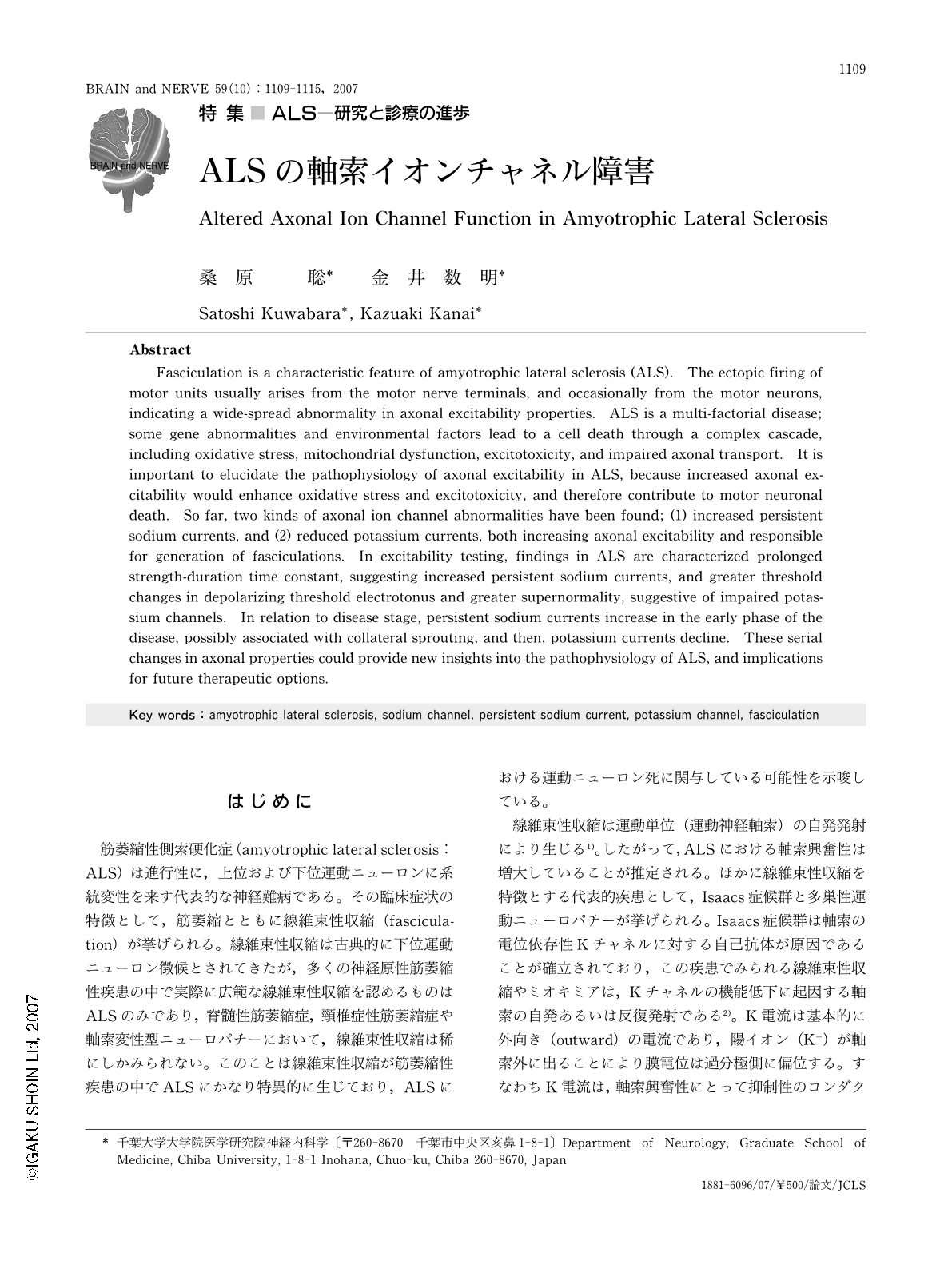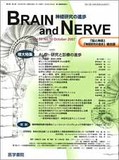Japanese
English
- 有料閲覧
- Abstract 文献概要
- 1ページ目 Look Inside
- 参考文献 Reference
はじめに
筋萎縮性側索硬化症(amyotrophic lateral sclerosis:ALS)は進行性に,上位および下位運動ニューロンに系統変性を来す代表的な神経難病である。その臨床症状の特徴として,筋萎縮とともに線維束性収縮(fasciculation)が挙げられる。線維束性収縮は古典的に下位運動ニューロン徴候とされてきたが,多くの神経原性筋萎縮性疾患の中で実際に広範な線維束性収縮を認めるものはALSのみであり,脊髄性筋萎縮症,頸椎症性筋萎縮症や軸索変性型ニューロパチーにおいて,線維束性収縮は稀にしかみられない。このことは線維束性収縮が筋萎縮性疾患の中でALSにかなり特異的に生じており,ALSにおける運動ニューロン死に関与している可能性を示唆している。
線維束性収縮は運動単位(運動神経軸索)の自発発射により生じる1)。したがって,ALSにおける軸索興奮性は増大していることが推定される。ほかに線維束性収縮を特徴とする代表的疾患として,Isaacs症候群と多巣性運動ニューロパチーが挙げられる。Isaacs症候群は軸索の電位依存性Kチャネルに対する自己抗体が原因であることが確立されており,この疾患でみられる線維束性収縮やミオキミアは,Kチャネルの機能低下に起因する軸索の自発あるいは反復発射である2)。K電流は基本的に外向き(outward)の電流であり,陽イオン(K+)が軸索外に出ることにより膜電位は過分極側に偏位する。すなわちK電流は,軸索興奮性にとって抑制性のコンダクタンスであるといえる。多巣性運動ニューロパチーにおける線維束性収縮のメカニズムは明らかではないが,病変部軸索の静止膜電位が脱分極側に偏位していることが仮説として提唱されている3)。軸索の自発発射を来す興奮性増大のメカニズムとして,①Naチャネル(特に持続性Naチャネル;下記参照)の活性化,②Kチャネルの機能低下,③静止膜電位の脱分極側への偏位,などが挙げられ,ALSにおける軸索興奮性にどのメカニズムが関与しているかが注目されてきた。
1990年代に英国国立神経研究所のHugh Bostockにより開発された,threshold tracking法を用いた軸索機能検査法は,1990年代後半から臨床応用が広まり,NaあるいはKチャネル機能を含めた軸索特性を非侵襲的に評価することが可能になった4,5)。この手法は,これまでパッチクランプなどの観血的な方法でしか得られなかった軸索イオンチャネルに関する情報を,簡便に得ることができる画期的な手法として普及しつつあり,英国,日本,豪州などの研究グループにより多くの報告がなされるようになっている6)。本稿ではこの方法を用いてALSにおける軸索興奮性の変化について,これまでに得られた知見について概説する。結論を先に述べると,ALSでは持続性Na電流の増大と,K電流の減少という2つの軸索特性の変化が存在し,相乗的に軸索興奮性を増大させて線維束性収縮の発生に関与していると考えられる。
Abstract
Fasciculation is a characteristic feature of amyotrophic lateral sclerosis (ALS). The ectopic firing of motor units usually arises from the motor nerve terminals, and occasionally from the motor neurons, indicating a wide-spread abnormality in axonal excitability properties. ALS is a multi-factorial disease; some gene abnormalities and environmental factors lead to a cell death through a complex cascade, including oxidative stress, mitochondrial dysfunction, excitotoxicity, and impaired axonal transport. It is important to elucidate the pathophysiology of axonal excitability in ALS, because increased axonal excitability would enhance oxidative stress and excitotoxicity, and therefore contribute to motor neuronal death. So far, two kinds of axonal ion channel abnormalities have been found; (1) increased persistent sodium currents, and (2) reduced potassium currents, both increasing axonal excitability and responsible for generation of fasciculations. In excitability testing, findings in ALS are characterized prolonged strength-duration time constant, suggesting increased persistent sodium currents, and greater threshold changes in depolarizing threshold electrotonus and greater supernormality, suggestive of impaired potassium channels. In relation to disease stage, persistent sodium currents increase in the early phase of the disease, possibly associated with collateral sprouting, and then, potassium currents decline. These serial changes in axonal properties could provide new insights into the pathophysiology of ALS, and implications for future therapeutic options.

Copyright © 2007, Igaku-Shoin Ltd. All rights reserved.


